What’s in Your Software Testing Tech Stack?
Summary: This article discusses the concept of a "testing tech stack" for quality assurance in software development, outlining key elements such as test management tools, test automation tools, performance testing tools, bug tracking systems, and others.
It’s common for an organization to refer to the software, libraries, infrastructure, and code that they use to run their business as their tech stack, which is short for “technology stack.”
But what about having a similar comprehensive approach to how your organization handles the quality assurance (QA) for these essential elements of your operations?
The tools, frameworks, and established processes that your team uses for planning, managing, and executing software QA can be thought of as your “testing tech stack.”
So what should your software testing tech stack include and what could structuring it in this manner do for your QA process?
The Importance of a Software Testing Tech Stack
Thinking holistically about the elements of your software testing process as an intertwined tech stack can introduce a number of key benefits to your development approach. For example, having the necessary tools accessible for testing means:
- Faster time-to-market: Identifying and resolving issues early in the development cycle with established processes and tools.
- Increased cost-effectiveness: Reducing the cost of fixing bugs in later stages, which could also include the opportunity costs of having to redesign an element or issue a patch.
- Higher customer satisfaction: Delivering a stable product that meets user expectations leads to repeat customers who become advocates.
- More comprehensive testing: Establishing plans and tests to cover the full range of software functionality consistently and more efficiently, allowing for faster development cycles.
Building and Maintaining Your Testing Tech Stack: 8 Key Elements
Here are some of the key elements that should comprise your software testing tech stack:
Test management tools: These provide a structured environment for creating, organizing, and running tests as well as managing a portfolio of testing projects.
Examples:
Examples:
- Selenium
- Appium
- Cypress
Examples:
- JMeter
- LoadRunner
- Gatling
- Apache Benchmark
Examples:
- TestMonitor
- Jira
- Asana
Examples:
- Travis CI
- CircleCI
- GitLab CI/CD
Examples:
- GitHub
- GitLab
- Bitbucket
- DoneDone
- DevOps
- ClickUp
- Wrike
Examples:
- Docker
- Kubernetes
- Vagrant
Examples:
- OWASP Zap
- Burp Suite
- Nessus
Selecting and Integrating Tools for an Efficient Testing Tech Stack
With so many elements that can comprise a testing tech stack and several vendors to choose from, here are some tips for selecting and integrating tools for your testing tech stack:
Criteria for Tool Selection
Selecting the software testing tools should focus on several criteria, including the product’s ease of integration or compatibility with other testing elements as well as how intuitive it is for your team to learn how to use. Other criteria can include the diversity of the product’s use cases (e.g., supporting large-scale projects and patches) and a strong community of support and documentation for continued feature enhancement and troubleshooting assistance.
Seamless Tool Incorporation and Integration
It’s likely that your organization already has several of the key elements of a software testing tech stack, but taking the time to map out your development and testing approach can help to identify which of the above pieces you’re missing. This mapping will also help to identify the data, inputs, and outputs that will be flowing between each element to ensure smooth integration and opportunities for automation.
Build Your Tech Stack Around TestMonitor
A well-curated software testing tech stack incorporates each of these key elements to give your team the tools they need to perform comprehensive testing, meet quick feedback loops, and experience efficient collaboration and continuous improvement throughout the software development lifecycle.
Fortunately, choosing a platform like TestMonitor means picking a test management tool that can facilitate many of these key functions—such as streamlining test management, boosting collaboration, and defect management—while easing integration with other key parts of your software testing tech stack.
Want to see just how well TestMonitor checks all of these must-haves (and much more)? Then click the link below to set up your own 14-day free trial of TestMonitor:






